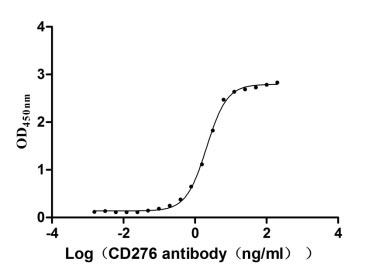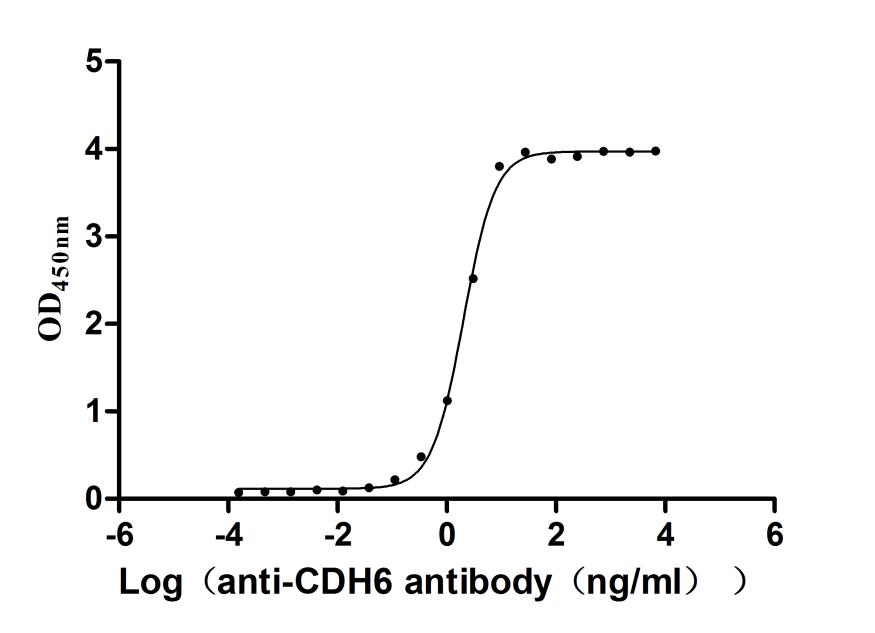Recombinant Human Excitatory amino acid transporter 1 (SLC1A3), partial
-
货号:CSB-YP021434HU
-
规格:
-
来源:Yeast
-
其他:
-
货号:CSB-EP021434HU-B
-
规格:
-
来源:E.coli
-
共轭:Avi-tag Biotinylated
E. coli biotin ligase (BirA) is highly specific in covalently attaching biotin to the 15 amino acid AviTag peptide. This recombinant protein was biotinylated in vivo by AviTag-BirA technology, which method is BriA catalyzes amide linkage between the biotin and the specific lysine of the AviTag.
-
其他:
-
货号:CSB-BP021434HU
-
规格:
-
来源:Baculovirus
-
其他:
-
货号:CSB-MP021434HU
-
规格:
-
来源:Mammalian cell
-
其他:
产品详情
-
纯度:>85% (SDS-PAGE)
-
基因名:
-
Uniprot No.:
-
别名:EA6; EAA1_HUMAN; EAAT1; Excitatory amino acid transporter 1; FLJ25094 ; GLAST; GLAST-1; GLAST1; Glial high affinity glutamate transporter; glutamate/aspartate transporter; high affinity; sodium-dependent; High affinity neuronal glutamate transporter; Slc1a3; Sodium dependent glutamate/aspartate transporter; Sodium-dependent glutamate/aspartate transporter 1; Solute carrier family 1 (glial high affinity glutamate transporter) member 3; Solute carrier family 1 member 3
-
种属:Homo sapiens (Human)
-
蛋白长度:Partial
-
蛋白标签:Tag type will be determined during the manufacturing process.
The tag type will be determined during production process. If you have specified tag type, please tell us and we will develop the specified tag preferentially. -
产品提供形式:Lyophilized powder
Note: We will preferentially ship the format that we have in stock, however, if you have any special requirement for the format, please remark your requirement when placing the order, we will prepare according to your demand. -
复溶:We recommend that this vial be briefly centrifuged prior to opening to bring the contents to the bottom. Please reconstitute protein in deionized sterile water to a concentration of 0.1-1.0 mg/mL.We recommend to add 5-50% of glycerol (final concentration) and aliquot for long-term storage at -20℃/-80℃. Our default final concentration of glycerol is 50%. Customers could use it as reference.
-
储存条件:Store at -20°C/-80°C upon receipt, aliquoting is necessary for mutiple use. Avoid repeated freeze-thaw cycles.
-
保质期:The shelf life is related to many factors, storage state, buffer ingredients, storage temperature and the stability of the protein itself.
Generally, the shelf life of liquid form is 6 months at -20°C/-80°C. The shelf life of lyophilized form is 12 months at -20°C/-80°C. -
货期:Delivery time may differ from different purchasing way or location, please kindly consult your local distributors for specific delivery time.Note: All of our proteins are default shipped with normal blue ice packs, if you request to ship with dry ice, please communicate with us in advance and extra fees will be charged.
-
注意事项:Repeated freezing and thawing is not recommended. Store working aliquots at 4°C for up to one week.
-
Datasheet :Please contact us to get it.
相关产品
靶点详情
-
功能:Sodium-dependent, high-affinity amino acid transporter that mediates the uptake of L-glutamate and also L-aspartate and D-aspartate. Functions as a symporter that transports one amino acid molecule together with two or three Na(+) ions and one proton, in parallel with the counter-transport of one K(+) ion. Mediates Cl(-) flux that is not coupled to amino acid transport; this avoids the accumulation of negative charges due to aspartate and Na(+) symport. Plays a redundant role in the rapid removal of released glutamate from the synaptic cleft, which is essential for terminating the postsynaptic action of glutamate.
-
基因功能参考文献:
- EAAT1 rs2731880 SNP is associated with amygdala functional connectivity in bipolar disorder. PMID: 30073554
- Episodic ataxias 6 is caused by heterozygous mutations in SLC1A3, which encodes a subunit of a glial excitatory amino acid transporter, EAAT1. PMID: 29891059
- a novel missense mutation, c.383T>G (p.Met128Arg) in SLC1A3, in an episodic ataxia patient by whole-exome sequencing. PMID: 29208948
- This is the first study to link SLC1A3 and EPHB2 to clinically relevant vertebral osteoporosis phenotypes. PMID: 27476799
- crystal structures of a thermostabilized human SLC1 transporter, the excitatory amino acid transporter 1 (EAAT1), with and without allosteric and competitive inhibitors bound PMID: 28424515
- This study demonstrated that the cytopathology and episodic paralysis in our Drosophila EA6 model stem from a gain-of-function chloride channelopathy of glial cells.. PMID: 27445142
- Starvation of Muller cells increased the glutamate uptake capacity as well as the expression of the most abundant glutamate transporter, EAAT1. PMID: 27196320
- A heterozygous SLC1A3 c.1177G4A mutation has been detected in a patient with late-onset episodic ataxia. Same heterozygous mutation was identified in one clinically affected family member and two asymptomatic members. PMID: 27829685
- We consider an association between SLC1A3 and the behavioural problems which can also be considered a contributing factor to behavioural problems in larger duplications overlapping the 5p13 microduplication syndrome region. PMID: 27296938
- In combination with other nearby residues, Arg-388 coordinates anion channel gating and forms part of the missing structural link between the anion conducting and substrate transport states in EAAT1. PMID: 26683197
- There was no association between pyramidal cell EAAT1 splice variant expression and schizophrenia. PMID: 26057049
- data provide additional insights into the mechanism by which substrates gate the anion conductance in EAATs and suggest that in EAAT1, Arg-388 is a critical element for the structural coupling between the substrate translocation and the gating mechanisms PMID: 26203187
- discovering compounds that can enhance EAAT1 expression and activity may be a novel strategy for therapeutic treatment of glaucoma. PMID: 25789968
- EAAT1 polymorphism which is involved in the Regulation of extracellular glutamate concentrations, influences Cognitive performances with a detrimental effect of T/T homozygosis. PMID: 25660734
- Its dysregulation may contribute to the pathology and possibly affect the onset of fragile X-associated tremor/ataxia syndrome. PMID: 24332449
- Increased SLC1A3 expression in the cerebellum of elderly schizophrenia patients indicates facilitated transport and may result in reduced glutamate neurotransmission. PMID: 22424243
- Plasma membrane EAAT1 (and NCX1)are both involved in glutamate-induced ATP synthesis. PMID: 23913256
- Decreased expression of EAAT1 protein remodels glutamate neurotransmission in the superior temporal gyrus in schizophrenia. PMID: 23356950
- Episodic ataxia type 6 represents the first human disease found to be associated with altered function of excitatory amino acid transporter anion channels. PMID: 23107647
- Close functional similarities of the GLAST/EAAT-1 promoter regions in man and rat exist which point to a species-specific function of the GLAST/EAAT-1 3'-UTR in constitutive and regulated GLAST/EAAT-1 expression. PMID: 22252783
- EAAT-1 expression was found in 91% of choroid plexus tumors and was absent in endolymphatic sac tumors. PMID: 22706862
- Letter: report expression of dishevelled-3 and EAAT1 and glutamine metabolism in malignant pleural mesothelioma. PMID: 22569537
- The accessibility in the external part of the TM5 of the glutamate transporter EAAT1 is conformationally sensitive during the transport cycle. PMID: 22292083
- These results indicate that E219D is a functional SLC1A3 variant that is presented in a small number of individuals with Tourette syndrome. PMID: 21233784
- water and urea permeation properties of wild-type EAAT1 and two mutant transporters were measured to identify which permeation pathway facilitates the movement of these molecules PMID: 21732909
- A series of single cysteine substitutions in the helical hairpin HP2 of excitatory amino acid transporter 1 form intersubunit disulfide cross-links within the trimer. PMID: 21876140
- There is no association between SLC1A3 and normal tension glaucoma (NTG), suggesting that the SLC1A3 gene may not be an associated factor in NTG pathogenesis. PMID: 21528001
- Dose-dependent modulation of EAAT1-mediated aspartate transport by benzodiazepines suggests a role of glial as well as neuronal transporters in drug action. PMID: 11792462
- EAAT1 was strongly expressed in a subset of cortical pyramidal neurons in dementia cases showing Alzheimer-type pathology. In addition, tau (which is a marker of neurofibrillary pathology) colocalized to those same pyramidal cells that expressed EAAT1 PMID: 11826152
- Data show that excitatory amino acid transporter (EAAT)-1 was expressed by activated macrophages/microglia in all HIV-infected cases but not in HIV-negative controls. PMID: 12769187
- To test whether Nedd4-2, SGK1, SGK3 and protein kinase B regulate EAAT1, cRNA encoding EAAT1 was injected into Xenopus oocytes with or without injection of Nedd4-2, constitutively active[CA] S422DSGK1, inactive K127NSGK1, SGK3 and/or CA T308D,S473DPKB PMID: 12911626
- Transcriptional regulation of human excitatory amino acid transporter 1 (EAAT1): cloning of the EAAT1 promoter and characterization of its basal and inducible activity in human astrocytes. PMID: 14713304
- We observed decreased glutamate uptake V(max), without modification of transporter affinity, in aging, which could be linked to the selective decrease of EAAT1 expression and mRNA. Moreover, in AD patients we found a further EAAT1 reduction. PMID: 14749132
- Only activated macrophages/microglia (AMM) expressed EAAT-1. Proportion of AMM expressing EAAT-1 did not correlate with severity of neuronal apoptosis, spongiosis, astrocytosis, microgliosis, or PrP deposition, but only with disease duration. PMID: 15535133
- EAAT1 parameters were mutually correlated (p<0.01) and correlations were shown with dementia severity (p<0.05 MMSE-expression, p<0.005 MMSE-mRNA). PMID: 15718040
- Genetic variation in SLC1A3 may contribute to susceptibility to ADHD. PMID: 15950021
- EAAT1ex9skip splice variant is a negative regulator of full-length EAAT1 function in the human brain PMID: 16042756
- Our data show that a heterozygous mutation in EAAT1 can lead to decreased glutamate uptake, which can contribute to neuronal hyperexcitability to cause seizures, hemiplegia, and episodic ataxia. PMID: 16116111
- the activity of glutamate transporter GLAST/EAAT1 can effectively regulate the cell surface expression of glutamine/neutral amino acid transporter ASCT2 in human fetal astrocytes PMID: 16516348
- Rearrangements in the tertiary structure of the EAAT1 translocation pore during transport provide constraints for modeling the structural dynamics associated with transport. PMID: 16877378
- SLC1A3 is unlikely to be a major susceptibility gene for schizophrenia in the Japanese population. PMID: 17221839
- Activity of GLAST directs FXYD2 protein/gamma subunit to the cell surface, that leads to the activation of the astroglial sodium pump. PMID: 17316900
- Continued expression of GLAST by neural progenitor cells in the transgenic mouse brain raises the possibility that GLAST may have an unanticipated role in regulating their behavior. PMID: 17581948
- We documented for the first time the expression of the mGluR5 and EAAT1 in MG-63 cells, as well as the ability of dexamethasone to upregulate the expression of the mGluR5 and EAAT1 in the MG-63 cells. PMID: 17627080
- Mutations in transmembrane domains 5 and 7 of the human excitatory amino acid transporter 1 affect the substrate-activated anion channel PMID: 17676873
- No pathogenic mutation were identified in SLC1A3. PMID: 18446307
- increased expression in the prefrontal cortex of chronic alcoholics PMID: 18657127
- analysis of the importance of Leu-303 or its counterpart Leu-391 in human EAAT1 (hEAAT1) PMID: 18678877
- We broadened the clinical spectrum associated with SLC1A3 mutations to include milder manifestations of EA without seizures or alternating hemiplegia. The severity of EA6 symptoms is related to the extent of glutamate transporter dysfunction. PMID: 19139306
显示更多
收起更多
-
相关疾病:Episodic ataxia 6 (EA6)
-
亚细胞定位:Cell membrane; Multi-pass membrane protein.
-
蛋白家族:Dicarboxylate/amino acid:cation symporter (DAACS) (TC 2.A.23) family, SLC1A3 subfamily
-
组织特异性:Detected in brain. Detected at very much lower levels in heart, lung, placenta and skeletal muscle. Highly expressed in cerebellum, but also found in frontal cortex, hippocampus and basal ganglia.
-
数据库链接:
HGNC: 10941
OMIM: 600111
KEGG: hsa:6507
STRING: 9606.ENSP00000265113
UniGene: Hs.481918
Most popular with customers
-
Recombinant Human CD276 antigen (CD276), partial (Active)
Express system: Mammalian cell
Species: Homo sapiens (Human)
-
Recombinant Dog B-lymphocyte antigen CD20 (MS4A1)-VLPs (Active)
Express system: Mammalian cell
Species: Canis lupus familiaris (Dog) (Canis familiaris)
-
Recombinant Human Early activation antigen CD69 (CD69), partial (Active)
Express system: Mammalian cell
Species: Homo sapiens (Human)
-
Recombinant Human Interleukin-2 receptor subunit alpha (IL2RA), partial (Active)
Express system: Mammalian cell
Species: Homo sapiens (Human)
-
Recombinant Human Carcinoembryonic antigen-related cell adhesion molecule 8(CEACAM8) (Active)
Express system: Mammalian cell
Species: Homo sapiens (Human)
-
Recombinant Human Myosin regulatory light chain 12B(MYL12B) (Active)
Express system: E.coli
Species: Homo sapiens (Human)
-
Recombinant Mouse Cadherin-6(Cdh6),partial (Active)
Express system: Mammalian cell
Species: Mus musculus (Mouse)



















